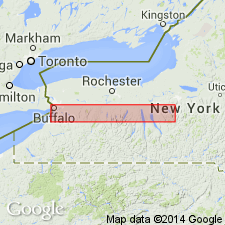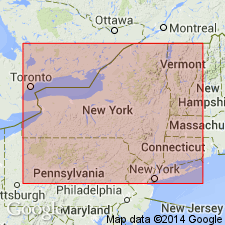
- Usage in publication:
-
- Fall Brook coral bed
- Modifications:
-
- Named
- Dominant lithology:
-
- Limestone
- AAPG geologic province:
-
- Appalachian basin
Summary:
The coral-rich unit in the upper part of the Windom Shale Member of the Moscow Formation of the Hamilton Group is here [informally] named the Fall Brook coral bed. It extends from eastern Genesee Co. to Seneca Co., NY. In the Genesee Valley area the bed contains large corals and other invertebrate fossils densely packed in a soft mudstone matrix. Thickens to the east, the fossil content lessens, and east of Seneca Lake the unit becomes indistinguishable. It is separated from the underlying Smoke Creek bed by 2 to 5 m of gray to black shale, the AMBOCOELLA? praeumbona zone. Underlies the "Spirifer-coralline" zone of Stover (1956), here termed the Taunton beds. Maximum thickness is 1.5 m. Age is Middle Devonian.
Source: GNU records (USGS DDS-6; Reston GNULEX).

- Usage in publication:
-
- Fall Brook coral bed
- Modifications:
-
- Areal extent
- Overview
- AAPG geologic province:
-
- Appalachian basin
Summary:
Interval is characterized by an abundance of large rugose corals, especially CYSTIPHYLLOIDES, HELIOPHYLLUM, and HETEROPHRENTIS. Unit contains an extremely diverse associated fauna including over 70 species of brachiopods, bryozoans, small-to-medium sized tabulate corals, mollusks, trilobites, and echinoderms. Fall Brook coral bed, 0.5 to 2 m in thickness, overlies the Fisher Gully beds (new, informal) of the Windom Member (Moscow Formation) and underlies the Taunton beds. Both contacts are distinct in the Genesee Valley area where the change to fossiliferous blue gray mudstones is abrupt, but toward the east the contacts are indistinct. Perry Ravine on the west side of Seneca Lake, south of Dresden, NY, is the easternmost locality at which the Fall Brook bed can be recognized as a discrete interval. Westward to Linden, Genesee Co, it is easily recognizable as a highly fossiliferous zone immediately below the Leicester Pyrite. Further west, the bed has been removed by erosion along with all underlying strata above the Bear Swamp beds. The Fall Brook does not reappear in Erie Co., though the Amsdell bed, equivalent to the Fisher Gully beds does. Age is Middle Devonian (Givetian).
Source: GNU records (USGS DDS-6; Reston GNULEX).
For more information, please contact Nancy Stamm, Geologic Names Committee Secretary.
Asterisk (*) indicates published by U.S. Geological Survey authors.
"No current usage" (†) implies that a name has been abandoned or has fallen into disuse. Former usage and, if known, replacement name given in parentheses ( ).
Slash (/) indicates name conflicts with nomenclatural guidelines (CSN, 1933; ACSN, 1961, 1970; NACSN, 1983, 2005, 2021). May be explained within brackets ([ ]).

